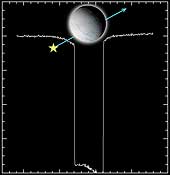|
COMETS EARTH JUPITER KUIPER BELT MARS MERCURY METEORITES NEPTUNE OORT CLOUD PLUTO SATURN SOLAR SYSTEM SPACE SUN URANUS VENUS ORDER PRINTS
PHOTO CATEGORIES SCIENCEVIEWS AMERICAN INDIAN AMPHIBIANS BIRDS BUGS FINE ART FOSSILS THE ISLANDS HISTORICAL PHOTOS MAMMALS OTHER PARKS PLANTS RELIGIOUS REPTILES SCIENCEVIEWS PRINTS
|
Related Documents
Download Options
During the July 14, 2005, flyby of Saturn's moon Enceladus, Cassini's ultraviolet imaging spectrograph made the first direct detection of an atmosphere, first suggested by Cassini magnetometer measurements. The ultraviolet imaging spectrograph observed the star Gamma Orionis as Enceladus crossed in front of the star. The light of the star dimmed as it was obscured by the atmosphere before being blocked entirely by Enceladus itself. The spectrum of the starlight changed as it passed through the atmosphere, indicating the presence of water vapor. The ultraviolet imaging spectrograph results suggest that the atmosphere of Enceladus is not constant and may be consistent with a greater amount of atmospheric gas near the south polar region. The presence of water vapor is more consistent with warm water ice than with magnetospheric sputtering. |
